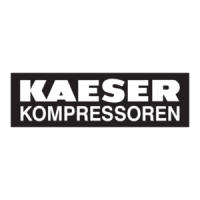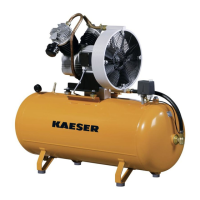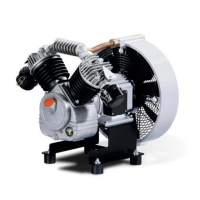Do you have a question about the KAESER ESD 442 SFC and is the answer not in the manual?
Highlights that dangers can arise from operation and emphasizes using the machine in a technically perfect condition.
Describes various forms of danger during machine operation, including electricity, compression forces, and rotating components.
Emphasizes that safety devices ensure safe working and should not be changed, bypassed, or disabled.
Provides guidance on dealing with emergencies, including correct fire fighting procedures and treating injuries.
Lists provided safety devices like EMERGENCY STOP, pressure relief valve, and guards, stating they cannot be changed.
Provides an overview of the operating panel, including keys and their functions for controlling the machine.
Explains the various indicators on the operating panel and their functions, such as Alarm, Warning, and LOAD status.
Emphasizes that installation and operating conditions significantly affect safety and warns against disregarding safety notes.
Provides instructions for safe installation, emphasizing authorized personnel and safety measures for live components and pressure systems.
Provides detailed instructions for connecting the power supply, emphasizing authorized personnel and safety measures.
Details the process of configuring the controller, including menu options, display language, and access rights.
Provides instructions for displaying and adjusting pressure parameters like setpoint pressure and system pressure low.
Outlines alternatives for machine start and stop, including automatic clock mode, holidays, and remote control.
Explains various control modes (DUAL, QUADRO, VARIO, DYNAMIC, CONTINUOUS) and how to adjust their settings.
Explains how to configure the machine for local mode, including pressure setpoint changeover using clock programs.
Describes methods for configuring master control, including Profibus, Ethernet, LOAD remote contact, and pressure switch regulation.
Details how to use binary and analog inputs/outputs for various requirements, including assigning messages and displaying data.
Provides a checklist for verifying controller settings before starting the machine.
Details the procedure for switching the machine on and off using the ON/OFF keys and power supply.
Explains how to use the EMERGENCY STOP button and the procedure for switching the machine on again after an emergency stop.
Describes how to acknowledge alarm and warning messages using the controller's LEDs and keys.
Explains how to access and interpret current messages, message history, compressor, diagnostic, and system messages.
Provides guidance on adjusting the pressure parameter to suit the compressor and application requirements.
Explains how to change service intervals for components like oil filter and oil separator.
Provides a step-by-step guide for testing the safety relief valve, including preparing, performing, and concluding the test.
Describes how to check the temperature sensor and overheating shutdown function by simulating a higher temperature.
Lists alarm messages identified by 'A', detailing possible causes and remedies for faults like direction of rotation or motor temperature.
States that SIGMA CONTROL 2 and I/O modules are maintenance-free and emphasizes basic safety instructions.
Details the procedure for checking the pressure relief valve by raising working pressure above its activating pressure.
Explains how to check the temperature sensor and overheating shutdown function by simulating a higher temperature.
Provides instructions for draining cooling oil from the oil separator tank, oil cooler, and compressor block, and changing filters.
Explains how to change the oil filter, including safety warnings and the trial run procedure.
Describes the process for changing the oil separator cartridge, noting it cannot be cleaned and its life is influenced by gas contamination.
Highlights that dangers can arise from operation and emphasizes using the machine in a technically perfect condition.
Describes various forms of danger during machine operation, including electricity, compression forces, and rotating components.
Emphasizes that safety devices ensure safe working and should not be changed, bypassed, or disabled.
Provides guidance on dealing with emergencies, including correct fire fighting procedures and treating injuries.
Lists provided safety devices like EMERGENCY STOP, pressure relief valve, and guards, stating they cannot be changed.
Provides an overview of the operating panel, including keys and their functions for controlling the machine.
Explains the various indicators on the operating panel and their functions, such as Alarm, Warning, and LOAD status.
Emphasizes that installation and operating conditions significantly affect safety and warns against disregarding safety notes.
Provides instructions for safe installation, emphasizing authorized personnel and safety measures for live components and pressure systems.
Provides detailed instructions for connecting the power supply, emphasizing authorized personnel and safety measures.
Details the process of configuring the controller, including menu options, display language, and access rights.
Provides instructions for displaying and adjusting pressure parameters like setpoint pressure and system pressure low.
Outlines alternatives for machine start and stop, including automatic clock mode, holidays, and remote control.
Explains various control modes (DUAL, QUADRO, VARIO, DYNAMIC, CONTINUOUS) and how to adjust their settings.
Explains how to configure the machine for local mode, including pressure setpoint changeover using clock programs.
Describes methods for configuring master control, including Profibus, Ethernet, LOAD remote contact, and pressure switch regulation.
Details how to use binary and analog inputs/outputs for various requirements, including assigning messages and displaying data.
Provides a checklist for verifying controller settings before starting the machine.
Details the procedure for switching the machine on and off using the ON/OFF keys and power supply.
Explains how to use the EMERGENCY STOP button and the procedure for switching the machine on again after an emergency stop.
Describes how to acknowledge alarm and warning messages using the controller's LEDs and keys.
Explains how to access and interpret current messages, message history, compressor, diagnostic, and system messages.
Provides guidance on adjusting the pressure parameter to suit the compressor and application requirements.
Explains how to change service intervals for components like oil filter and oil separator.
Provides a step-by-step guide for testing the safety relief valve, including preparing, performing, and concluding the test.
Describes how to check the temperature sensor and overheating shutdown function by simulating a higher temperature.
Lists alarm messages identified by 'A', detailing possible causes and remedies for faults like direction of rotation or motor temperature.
States that SIGMA CONTROL 2 and I/O modules are maintenance-free and emphasizes basic safety instructions.
Details the procedure for checking the pressure relief valve by raising working pressure above its activating pressure.
Explains how to check the temperature sensor and overheating shutdown function by simulating a higher temperature.
Provides instructions for draining cooling oil from the oil separator tank, oil cooler, and compressor block, and changing filters.
Explains how to change the oil filter, including safety warnings and the trial run procedure.
Describes the process for changing the oil separator cartridge, noting it cannot be cleaned and its life is influenced by gas contamination.
| Model | ESD 442 SFC |
|---|---|
| Category | Air Compressor |
| Power | 45 kW |
| Motor Power | 45 kW |
| Voltage | 400 V |
| Frequency | 50 Hz |
| Type | Rotary Screw Compressor |
| Dimensions | 2420 x 2000 x 2150 mm |
| Drive Type | Direct Drive |
| Dimensions (LxWxH) | 2420 x 2000 x 2150 mm |












